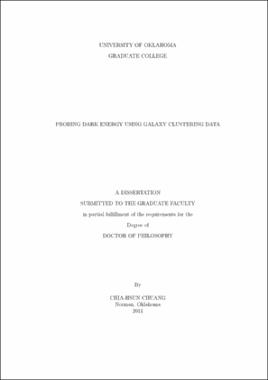| dc.contributor.advisor | Wang, Yun | |
| dc.creator | Chuang, Chia-Hsun | |
| dc.date.accessioned | 2019-04-27T21:29:17Z | |
| dc.date.available | 2019-04-27T21:29:17Z | |
| dc.date.issued | 2011 | |
| dc.identifier | 99230280702042 | |
| dc.identifier.uri | https://hdl.handle.net/11244/318805 | |
| dc.description.abstract | Dark energy is the most important unsolved mystery in cosmology today. Galaxy clustering provides one of the prime probes of dark energy. This work is focused on developing robust analysis techniques for interpreting galaxy clustering data. These are crucial for probing dark energy using galaxy clustering data. | |
| dc.description.abstract | First, we present a method to measure the effective distance to z=0.35, DV(0.35) from the overall shape of the spherically-averaged two-point correlation function (2PCF) of the Sloan Digital Sky Survey Data Release 7 luminous red galaxy sample. We find DV(0.35) = 1428-73+74Mpc without assuming a dark energy model or a flat Universe. We find that the derived measurement of rs(zd)/DV(0.35) = 0.1143 ± 0.0030 (the ratio of the sound horizon at the drag epoch to the effective distance to z=0.35) has tighter constraint and is more robust with respect to possible systematic effects. It is also nearly uncorrelated to Ωm h^2 which might be sensitive to systematic effects. | |
| dc.description.abstract | Then, we generalize the method to measure the Hubble parameter, H(z), and angular diameter distance, DA(z), from the two-dimensional 2PCF, and we find H(0.35) = 82.1-4.9+4.8km/s/Mpc, DA(0.35)=1048-58+60Mpc. We also find that the derived measurements of {H(0.35)rs(zd), rs(zd)/DA(0.35)} = {13020 ± 530 km/s, 0.1518 ± 0.0062} (with the correlation coefficient r = -0.0584) are nearly uncorrelated, have tighter constraints and are more robust with respect to possible systematic effects. Combining our results with the cosmic microwave background and supernova data, we obtain Ωk=-0.0004 ± 0.0070 and w=-0.996 ± 0.043 (assuming a constant dark energy equation of state). | |
| dc.description.abstract | Our results represent the first measurements of H(z) and DA(z) from galaxy clustering data. Our work has significant implications for future surveys in establishing the feasibility of measuring both H(z) and DA(z) from galaxy clustering data. | |
| dc.format.extent | 70 pages | |
| dc.format.medium | application.pdf | |
| dc.language | en_US | |
| dc.relation.requires | Adobe Acrobat Reader | |
| dc.subject | Dark energy (Astronomy) | |
| dc.subject | Galaxies--Clusters | |
| dc.title | Probing Dark Energy Using Galaxy Clustering Data | |
| dc.type | text | |
| dc.type | document | |
| dc.thesis.degree | Ph.D. | |
| ou.group | College of Arts and Sciences::Homer L. Dodge Department of Physics and Astronomy | |
